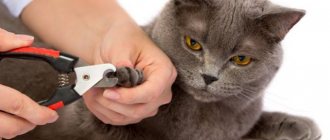Save the article:
Evolution has changed the appearance of cats, but has left such an important tool as claws unchanged. Cats can sort things out with rivals with the help of sharp claws, as well as get food and help take a high, impregnable fortress. This is all understandable if the cat is wild and a threat to the streets. But in domestic cats, declawing is a fairly common procedure.
Often, a pet’s claws are removed due to problems associated with the kitten growing up: no one likes damage to property, and even if the cat is particularly grumpy, the owners themselves may suffer.
The surgical procedure that makes a cat's paws “soft” is called onychectomy. During the operation, the entire claw phalanx is removed. In addition to cats, onychectomy is performed on dogs, primates and, if necessary, birds. Declawing is generally carried out according to indications and always under general anesthesia.
At what age can a cat be declawed?
Owners who are thinking about having a cat declawing operation are concerned about the question of when they can start the procedure. But before taking such extreme measures for cats who have the opportunity to walk, take into account that the animal will remain defenseless.
A kitten should not have its claws removed: their soft scratches do not cause harm; the body continues to form. In addition, it is absolutely cruel to subject a child to such stress.
According to the veterinarian’s recommendations, declawing surgery is performed on a kitten no earlier than 6-7 months. But it would be better to do it within a period of eight months to a year: the cardiovascular system has already become stronger, and the cat will have to get used to the consequences of walking without claws and adapt again in life situations. Therefore, if the owner has already decided to take such measures, then there is no need to delay and wait - in the absence of serious medical contraindications, the operation is easier to tolerate at a young age.
Functional purpose of claws
A cat has five toes on each paw that end in claws. The peculiarity of the latter is that they are hidden in leather bags. That is why when walking they do not touch the floor, and therefore do not become dull.
In its normal state, the claw is hidden in a leather pouch
A cat needs claws for:
- grabbing prey;
- moving around trees and other objects;
- defense
The claw point is a vital necessity for every cat. But they do this not against furniture, but with their teeth. A cat can scratch a sofa or carpet for several reasons:
- try to remove the old claw shell if a new one is already growing;
- mark territory - there are glands on the pads that secrete a special secretion, which the cat leaves on the surface of objects;
- train muscles - scratching pieces of furniture for a cat is a kind of exercise that the animal most often does after waking up.
Advantages and disadvantages of declawing cats
global $ads_google;
//data-ad-slot=”2475549904″ $ads_google = empty($ads_google) ? false : true; ?> if ($ads_google == false) {?> $ads_google = true; ?> } ?> It doesn't take long to remove a cat's claws. But are there any advantages from this? Yes, I have. This is the impossibility of damaging furniture and the absence of scratches on the skin of household members.
But the disadvantages include a number of points:
- anesthesia is not just a dream, but stress for the body;
- the animal is in great pain for a very long time after the operation. The pain is dulled with various painkillers, which is also considered an intervention in the body;
- the phalanx may grow back and require repeated surgery;
- This is real stress for a cat, which not every animal experiences without consequences.
- a cat without claws is defenseless, and any trip outside can end in disaster;
- as a result of onychectomy and a feeling of vulnerability, the pet may use its teeth;
- the pet’s character changes, it may become withdrawn;
- Difficulties with the toilet: sometimes cats refuse to go to the litter box due to the inability to rake;
- the animal will never step on the entire foot completely again in its life, which affects its gait.
Therefore, maybe it’s worth thinking about other options for protecting furniture from cat scratches?
Possible indications and contraindications
Despite the fact that the operation is often performed due to complaints from animal owners such as “knocking up all the furniture in the house,” “scratching everyone,” etc., there are possible medical indications for it, including:
- advanced stages of onychomycosis (fungal infection of the claws);
- epilepsy in an animal, to protect it from possible injuries during seizures;
- developmental abnormalities that cause frequent problems with ingrown nails (they constantly curl and cut into the pads of the paws, causing pain and lameness).
Other relative indications include:
- aggressive disposition of the animal, provided that it is impossible to use alternative options (paw attachments, claw trimming, etc.)
- the risk of cat scratch disease for people with weakened immune systems - complications after scratches caused by the bacteria Bartonella henselae, which lives on the claws. If they enter the human body, they can cause fever, swelling of the lymph nodes, and in some cases damage to the visual organs and nervous system, and blood poisoning.
As for contraindications, “Soft Paws” is strictly prohibited for cats with an outdoor lifestyle, since if necessary, they will not be able to defend themselves, climb a tree, or catch themselves when falling.
Description of declawing surgery
Onychectomy is banned in a number of European countries.
Local anesthesia is sometimes used for the operation, but general anesthesia is more often used.
The claws are removed entirely from the first phalanx of the finger. A suture and anesthetic ointment are applied to the damaged area. Then the paw is bandaged, and a collar is put on the cat’s neck, which will protect the seams from licking.
Along with the application of anesthetic ointment, auxiliary injections are administered.
How is the procedure performed?
“Soft paws” is not just the removal of the cat’s claws as such, but their removal along with the terminal phalanges of the fingers. It is performed under combined anesthesia, when general anesthesia and local anesthesia are used simultaneously. The procedure itself takes about 30-40 minutes, during which the claws are carefully removed using surgical instruments, and sutures are placed at the incision sites.
Post-operative recovery takes about 3-4 weeks. at this time you need:
- daily treatment of seams with an antiseptic;
- a protective collar to prevent the cat from licking the stitches, which are removed after 7-14 days;
- antibiotic therapy as prescribed by a doctor to reduce the risk of infections;
- using silica gel or paper instead of cat litter.
In addition, the cat needs close attention and care from the owner while it gets used to new living conditions.
Consequences of deletion
After the operation, the following consequences may appear:
- soft tissues after such an injury on the paws become inflamed, which is fraught with the onset of a necrotic process;
- Losing a large amount of blood during the declawing procedure complicates the healing process;
- impaired coordination of movements;
- difficulties associated with recovery from anesthesia.
Before the operation, consult a doctor at the clinic and identify the presence of serious medical indications: sometimes the cat actually needs to have 1-2 claws removed. In any case, first assess all the risks, and then begin the procedure.
Rehabilitation period
The recovery period depends on the quality of the work performed, the professionalism of the veterinarian and the cat’s reaction to the operation.
A high-quality procedure is the key to a quick recovery
Immediately after the procedure, the cat will sleep: do not be alarmed, the animal may pee under itself and this is a normal reaction to anesthesia.
For the first few days, your pet will not be able to walk: he will be bothered by pain in his paws, joints and back. Use an Elizabethan collar and do not allow your pet to touch the bandages. Every day it is necessary to treat the seams and make sure that the cat does not lick them. Walking outside is completely excluded during this period: there is a high probability of infection of the affected tissues.
IMPORTANT: place the tray, bowl and bed as close to each other as possible, thereby reducing the distances your pet will have to travel!
Rehabilitation of cats after onychectomy
When the cat's claws are removed, the process of recovery after surgery begins, both for the condition of the paws and for the entire body. Fluffy needs the caring attitude of the owner.
There are a number of nuances for caring for a cat:
- pain relief in the form of injections, if necessary;
- daily treatment of wounds;
- the dressing needs to be changed regularly;
- A visit to the doctor is recommended once a week
.
The cat is really looking forward to its owner's love and care, only in this case it will get better sooner.
The recovery period after surgery lasts a month. During the first few days it is painful for the cat to stand on its paws; it will be hampered by pain and discomfort. Then the walking process gradually improves, but the cat may limp.
It is better to remove the cat's claws first on the front paws and then on the back paws. One by one deletion is allowed. This requires expert advice.
Alternatives to surgery
Onychectomy is a radical method. You can solve the problem of furniture damage in other ways that have a temporary effect:
- nail trimming (can be done independently or in veterinary clinics);
- the use of anti-scratch pads - silicone overlays on the claws, which are attached using special glue (they need to be changed monthly);
Silicone claw covers need to be changed once a month.
- training to use a scratching post;
A cat can be trained to sharpen its claws in only one place
- the use of repellent sprays (they contain natural ingredients that are safe for animals);
- purchasing toys that will distract your cat from scratching furniture.
Video: how to avoid damage to furniture by cats
Cost of declawing
global $ads_google;
//data-ad-slot=”2475549904″ $ads_google = empty($ads_google) ? false : true; ?> if ($ads_google == false) {?> $ads_google = true; ?> } ?> If we take into account the price of declawing a cat within the central district of Russia, then the total cost can range from 1,500 to 5,000 rubles. The status of the clinic, the skill of the doctor, and the distance from the city center play a role.
There are veterinarians who specialize in surgery, and they should be given preference.
If you call a doctor to remove a cat’s claws at home, the price will not increase much, and healing will be faster.
Consequences, risks and complications
The psychological consequences can be unpredictable: adapting to a new lifestyle and experiencing severe stress, the animal can become irritable, withdrawn, and aggressive. Having lost a vital organ, a pet may perceive this as a danger and begin to avoid people. The situation is fraught with problems with going to the litter box: the cat may lose interest in the box due to the inability to “bury” the filler.
Possible physical effects, risks and complications include:
– prolonged and severe pain, inability and discomfort;
– deterioration of condition after anesthesia;
– violation of coordination and functions of the vestibular apparatus: the center of gravity shifts to the entire paw;
– osteomyelitis: inflammatory infectious disease of the bones;
– curvature of the spine, joint diseases;
– risk of developing an inflammatory infectious process;











